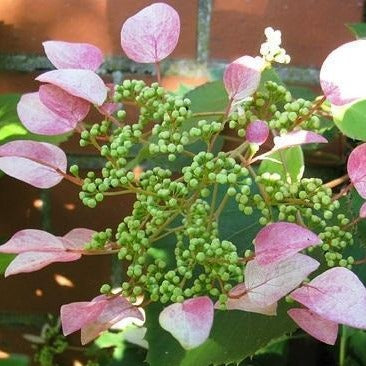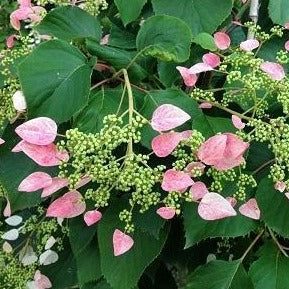Pink Climbing Hydrangea Vine
Product Details
 Growing Zones 5-9
Growing Zones 5-9
| Soil Type | Adaptable |
| Sunlight | Full, Partial, Shade |
| Drought Tolerance | Semi |
| Mature Height | 40-60 Feet |
| Mature Width | 10-15 Feet |
| Growth Rate | slow |
| Fall Color | Yellow |
| Bloom Color | Pink |
| Shipping Restriction | AZ |
The Pink Climbing Hydrangea is a truly unique treasure. You won't see this exquisite beauty at your local garden center! Sculpt your landscape into one of a kind with the breathtaking Pink Climbing Hydrangea vine. This easy to grow beauty is a crowd pleaser. You are sure to have admirers!
Pink, lacecap flowers and lush, green foliage dance over old, ugly fences and barren walls transforming them into a vivacious masterpiece. Create a cottage or wedding garden around an arbor or trellis coated in lacy, feminine pink flowers and dense, green leaves. This vine makes a spectacular groundcover like nothing you have seen before! Allow it to choose its own path, crawling along the ground, over rocks, and down slopes and low walls.
The Climbing Hydrangea can be used in place of invasive ivy for the walls of your home. It is deciduous so it helps conserve energy by allowing sun to penetrate in winter and shading your home from the sun in summer. This saves you money and is great for the environment! Let this noninvasive, but clingy vine crawl up a boring shade tree for a stunning look. It blooms in sun or shade so your options are endless!
While this lovely, large vine is slow to get started it is well worth the wait! After this establishment period the Climbing Hydrangea takes off and quickly fills in those boring or unsightly spots in your landscape. This hydrangea grows in sun or SHADE! YES, it even flowers in shade! Like other hydrangeas, the climbing hydrangea will do best with some shade especially in warmer climates.
Plant in moist, well-draining soil and fertilize with our slow release fertilizer when planting and in spring. Fertilize in late summer or early fall too for an extra boost, especially if you have deficient soil. No pruning is needed other than to control size and maintain the look you want. This hydrangea is a low maintenance plant with a lot to offer!
Transform your landscape with the stunning Pink Climbing Hydrangea! Order yours today! They won't stay in stock for long!
How Do I Get My Climbing Hydrangea To Flower?
This vine will blooms alot more flowers when exposed to full sun conditions. Fertilize once in spring and again in summer for best results. Keep pruning to a minimum to prevent any delays in blooming.
What Are Good Companion Plants For This Vine?
Azaleas, hydrangeas, and pieris blend well with this vine which serves as a unique groundcover that creeps along the garden, over rocks, or down slopes.
Where Should I Plant This Hydrangea?
This vine is adaptable to variety of soil types and thirves in full sun, part shade, or shady conditions in grow zones 5-9. This hydrangea climbs walls, fences, and trellis making it an inexpensive way to mask an ugly fence.
The Climbing Hydrangea can grow in full sun to full shade and prefers moist, well-drained, fertile soil. In warmer climates, be sure this Hydrangea has some shade. Keep the soil moist, but not saturated, especially in summer and in the first year after planting. Throughout its life Hydrangeas will do best with a deep watering once weekly during hot temperatures. Mulching at about 3 inches deep is highly recommended for hydrangeas. Mulching will cut back on watering needs and protect your plant in extreme temperatures. Choose a slow release fertilizer (like the one you can purchase here). Fertilize once in spring and again in summer for best results. You don’t need to prune this hydrangea, but pruning after blooming has ceased can help encourage a denser growth, renew an older plant, and maintain size.
The best way to prevent disease and pests is by providing the appropriate care for your plants. Proper location choice, watering, and fertilization are the keys to your success. You can treat mites, scale, whiteflies, and aphids naturally with neem oil or insecticidal soap. For severe infections you can use pesticides like carbaryl, also known as Sevin. Fungal infection can be prevented by making sure the planting site has good drainage and by avoiding overhead watering. Fungal infections can be treated with a fungicide. Generally, treating fungus after infection isn't effective so if you have problems with other plants or in a prior year, treat preventatively in early spring.












